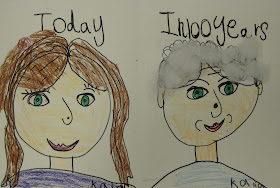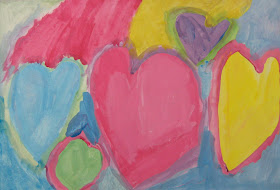 Even Van Gogh himself would be proud of this copy of his "Café Terrace" painting, created by our 2nd graders to raise money at our annual school auction.
Even Van Gogh himself would be proud of this copy of his "Café Terrace" painting, created by our 2nd graders to raise money at our annual school auction.Each year, our school holds a fundraiser auction to raise money for special programs. While many valuable items are donated to be auctioned off, the items that create the most excitement are usually our special "class projects". These are art projects created as a joint effort by each class, with each student contributing a part of the finished piece.
This year our 2nd graders made a copy of Vincent Van Gogh's "The Café Terrace on the Place du Forum, Arles, at Night" and as you can see, it is magnificent! Here's how you can make one, too:
This year our 2nd graders made a copy of Vincent Van Gogh's "The Café Terrace on the Place du Forum, Arles, at Night" and as you can see, it is magnificent! Here's how you can make one, too:
1. First, divide a fine art poster (you can find these inexpensively at art.com) into the same number of equal-sized sections as you have students. (If the numbers don't work out exactly right, consider having the teacher, principal or other school "celebrities" create a section, too.) Carefully cut the poster into separate pieces. (It can "feel wrong" to cut up a perfectly good art poster, but the end result is worth it!)
2. Next, number the pieces on the back and draw an arrow pointing to the "top".
3. Now, cut heavy weight black paper to the same size and distribute one piece to each student, along with their piece of the poster. Copy the number and arrow from the back of each poster piece to the back of the black paper.
3. Then, have students use oil pastels to re-create their section of the poster onto the black paper. For best results, remind them to focus on just copying the shapes, colors and placement of what they see on their poster section and to try not to think so much about what those shapes and colors represent. Encourage them to mix and their layer colors for a richer, more interesting effect and to cover the entire paper with oil pastel.... don't leave any black paper showing!
4. Finally, reassemble the finished pieces and use "YES!" Paste to glue them down onto a piece of black mat board, leaving about a 1/4" space between the pieces. (Frame your creation with spacers along the edge between the mat board and the glass.)
Helpful tip: You can save a lot of money by using a ready-made frame for your creation, rather than having it custom-framed. To do this, it helps to find your frame first, then work backwards to choose the size of your art poster, allowing for the 1/4" space you will leave between the pieces. Posters can also be enlarged into murals using this technique, but that project is better for 4th grade and up, as changing sizes can be very confusing for younger kids.




































